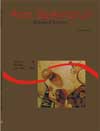Comparação da anastomose traqueal suturada com fio absorvível e inabsorvível em coelhos
Resumo
Neste trabalho foram comparados aspectos mofológicos e morfométricos da anastomose traqueal em coelhos, com a sutrua realizada por dois fios sintéticos absorvíveis e dois fios sintéticos inabsorvíveis. Os animais foram separados em três grupos iguais de 24 animais (A, B e C), estudos nos 7º, 14º e 28º dias de pós-operatório. Cada grupo foi dividido em quatro subgrupos iguais de seis animais. Após a excisão de três anéis cartilaginosos, a anastomose traqueal foi realizada com o fio de poligalactina 910, polidioxanona, polipropileno ou poliéster. Ao exame macroscópico, verificou-se que ocorreu uma fístula traqueal no 7º dia de pós-operatório na anastomose suturada com o fio de poliéster. A estenose cicatricial ocorreu com maior intensidade e freqüência com os fios de poliéster e polidioxanona, em todos os períodos de observação. No 14º e 28º dias de pós-operatório, verificou-se, à microscopia óptica, reação inflamatória crônica com intensidade maior nas suturas com os fios de poliéster, polidioxanona e polipropileno, nesta ordem, com nítida correlação entre a resposta inflamatória crônica intensa e os maus resultados macroscópicos observados nas anastomoses onde foram utilizados estes fios. Os resultados obtidos permitiram concluir que o fio de poligalactina 910 apresentou os melhores resultados cicatriciais para a anastomose traqueal dos coelhos, seguido pelo fio de polipropileno. Os fios de polidioxanona e poliéster apresentaram os piores resultados para a cicatrização da anastomoseDownloads
DECLARAÇÃO DE ORIGINALIDADE E DIREITOS AUTORAIS
Declaro que o presente artigo é original, não tendo sido submetido à publicação em qualquer outro periódico nacional ou internacional, quer seja em parte ou em sua totalidade.
Os direitos autorais pertencem exclusivamente aos autores. Os direitos de licenciamento utilizados pelo periódico é a licença Creative Commons Attribution 4.0 (CC BY 4.0): são permitidos o compartilhamento (cópia e distribuição do material em qualqer meio ou formato) e adaptação (remix, transformação e criação de material a partir do conteúdo assim licenciado para quaisquer fins, inclusive comerciais.
Recomenda-se a leitura desse link para maiores informações sobre o tema: fornecimento de créditos e referências de forma correta, entre outros detalhes cruciais para uso adequado do material licenciado.












1.png)




3.png)













